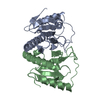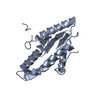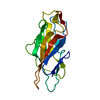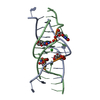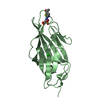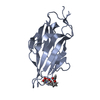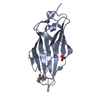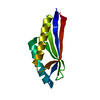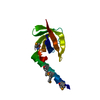+ データを開く
データを開く
- 基本情報
基本情報
| 登録情報 | データベース: SASBDB / ID: SASDCA6 |
|---|---|
 試料 試料 | SirA-like protein (DSY4693) from Desulfitobacterium hafniense, Northeast Structural Genomics Consortium Target DhR2A
|
| 機能・相同性 | Selenium metabolism protein YedF / TusA-like domain / Sulfurtransferase TusA / TusA-like domain superfamily / DsrEFH-like / UPF0033 domain-containing protein 機能・相同性情報 機能・相同性情報 |
| 生物種 |  Desulfitobacterium hafniense (strain Y51) (バクテリア) Desulfitobacterium hafniense (strain Y51) (バクテリア) |
 引用 引用 |  ジャーナル: Biopolymers / 年: 2011 ジャーナル: Biopolymers / 年: 2011タイトル: Small angle X-ray scattering as a complementary tool for high-throughput structural studies. 著者: Thomas D Grant / Joseph R Luft / Jennifer R Wolfley / Hiro Tsuruta / Anne Martel / Gaetano T Montelione / Edward H Snell /  要旨: Structural crystallography and nuclear magnetic resonance (NMR) spectroscopy are the predominant techniques for understanding the biological world on a molecular level. Crystallography is constrained ...Structural crystallography and nuclear magnetic resonance (NMR) spectroscopy are the predominant techniques for understanding the biological world on a molecular level. Crystallography is constrained by the ability to form a crystal that diffracts well and NMR is constrained to smaller proteins. Although powerful techniques, they leave many soluble, purified structurally uncharacterized protein samples. Small angle X-ray scattering (SAXS) is a solution technique that provides data on the size and multiple conformations of a sample, and can be used to reconstruct a low-resolution molecular envelope of a macromolecule. In this study, SAXS has been used in a high-throughput manner on a subset of 28 proteins, where structural information is available from crystallographic and/or NMR techniques. These crystallographic and NMR structures were used to validate the accuracy of molecular envelopes reconstructed from SAXS data on a statistical level, to compare and highlight complementary structural information that SAXS provides, and to leverage biological information derived by crystallographers and spectroscopists from their structures. All the ab initio molecular envelopes calculated from the SAXS data agree well with the available structural information. SAXS is a powerful albeit low-resolution technique that can provide additional structural information in a high-throughput and complementary manner to improve the functional interpretation of high-resolution structures. |
- 構造の表示
構造の表示
| 構造ビューア | 分子:  Molmil Molmil Jmol/JSmol Jmol/JSmol |
|---|
- ダウンロードとリンク
ダウンロードとリンク
-モデル
| モデル #1410 |  タイプ: dummy / ダミー原子の半径: 1.25 A / カイ2乗値: 1.723969  Omokage検索でこの集合体の類似形状データを探す (詳細) Omokage検索でこの集合体の類似形状データを探す (詳細) |
|---|---|
| モデル #1414 |  タイプ: atomic / ダミー原子の半径: 1.90 A / カイ2乗値: 17.875984  Omokage検索でこの集合体の類似形状データを探す (詳細) Omokage検索でこの集合体の類似形状データを探す (詳細) |
- 試料
試料
 試料 試料 | 名称: SirA-like protein (DSY4693) from Desulfitobacterium hafniense, Northeast Structural Genomics Consortium Target DhR2A 試料濃度: 0.92-4.43 |
|---|---|
| バッファ | 名称: 5 mM DTT 100 mM NaCl 10 mM Tris-HCl 0.02 % NaN3 / pH: 7.5 |
| 要素 #742 | タイプ: protein / 記述: Uncharacterized protein / 分子量: 9.383 / 分子数: 1 / 由来: Desulfitobacterium hafniense (strain Y51) / 参照: UniProt: Q24NB0 配列: MITIDALGQV CPIPVIRAKK ALAELGEAGG VVTVLVDNDI SRQNLQKMAE GMGYQAEYLE KDNGVIEVTI VAGEGCAVEL EHHHHHH |
-実験情報
| ビーム | 設備名称: Stanford Synchrotron Radiation Lightsource (SSRL) BL4-2 地域: Stanford, CA / 国: USA  / 線源: X-ray synchrotron / 波長: 0.13 Å / スペクトロメータ・検出器間距離: 1.5 mm / 線源: X-ray synchrotron / 波長: 0.13 Å / スペクトロメータ・検出器間距離: 1.5 mm | ||||||||||||||||||
|---|---|---|---|---|---|---|---|---|---|---|---|---|---|---|---|---|---|---|---|
| 検出器 | 名称: Rayonix MX225-HE | ||||||||||||||||||
| スキャン | 測定日: 2010年2月12日 / 保管温度: -80 °C / セル温度: 20 °C / 照射時間: 1 sec. / フレーム数: 20 / 単位: 1/A /
| ||||||||||||||||||
| 距離分布関数 P(R) |
| ||||||||||||||||||
| 結果 |
|
 ムービー
ムービー コントローラー
コントローラー


 SASDCA6
SASDCA6




